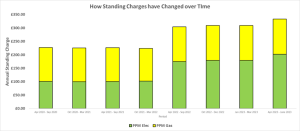For release 31 March 2023 00:01
Contact: Anna Cook, Head of Communications (anna.cook@nea.org.uk)
Mobile: 07884 371913
New report reveals energy standing charges set to increase to new high, up by 64%, leaving low-income households worst hit
- Despite the UK Government’s commitment to freeze the level of the Energy Price Guarantee (EPG) from 1 April, Standing Charges for prepayment customers will hit £350 for a dual fuel household. For the typical customer, standing charges have increased by two thirds since the introduction of the 2019 Ofgem price cap
- New report finds that high standing charges disproportionately affect low-income households, in particular prepayment customers, meaning 13% of the typical dual fuel energy bill is unavoidable
- Higher standing charges hit at the same time as the Energy Bills Support Scheme rebate closes, leaving 7.5 million UK households in fuel poverty
A new report released today warns standing charges have reached a new high. The new level of the Ofgem price cap for energy, which comes into force on 1 April, will result in the highest standing charge for energy customers, since the Ofgem price cap was introduced in 2019. It’s an increase of 64%.
This comes as the number of UK households in fuel poverty is set to increase from 6.7 million to a new high of 7.5 million from 1 April, according to National Energy Action’s figures.
Many people think energy bills won’t rise on 1 April, but that’s not the case. The Government are keeping the Energy Price Guarantee, keeping the annual bill for typical households at £2,500. But, as well as the standing charge increase, the Government is stopping the Energy Bills Support Scheme payments of £67 a month, meaning energy bills will increase by 40% a year.
The new report, produced by Ideal Economics and commissioned by National Energy Action, notes that despite the cost of failed energy suppliers largely being paid off, multiple decisions taken by the energy regulator, Ofgem, has led to standing charges soaring.
The new report highlights that high standing charges disproportionately affect low-income households, in particular prepayment customers. The report, written by David Osmon, concludes that:
- Low-income households spend less on energy so a higher proportion of what they pay goes on the standing charge and buys them no energy
- The lower spending of households with low incomes means that having to pay higher standing charges constitutes a significant cost increase that accentuates the effect on the amount of energy they can buy.
- A standing charge of £350 per annum accounts for 41% of what those in the poorest 10% of households have available to spend on energy and leaves them with only £508 worth of gas and electricity every year.
Adam Scorer, chief executive of fuel poverty charity National Energy Action (NEA) says:
‘For years, the standing charge has been growing. It makes life worse for low-income households who cannot afford the cost of a warm, safe home and have no choice but to cut back on their energy consumption.
‘Despite the UK Government’s recent commitment to freeze the level of the Energy Price Guarantee (EPG) from 1 April, standing charges will reach record levels. The regulator controls how costs are passed through to consumers. We know that low-income households lose out the most from its default approach to standing charges. It is high time for change.’
In the Budget on 15 March 2023, the UK Government announced that from July 2023 to March 2024 it will compensate prepayment customers for the additional cost (i.e. the higher standing charges) they face relative to those who pay by direct debit. This will cost the taxpayer £200 million.
However, prepayment customers still have to pay this extra for the three months until July; standing charges will remain very high for all consumers; and it is unclear what will happen from April next year. The author of the report says the current approach leaves more than 13% of the typical dual fuel energy bill being unavoidable. Even desperate efforts to slash virtually all households use of energy aren’t enough to stop prepayment meters from racking up increasing daily charges. The increases to standing charges also coincide with the end of the UK Government’s Energy Bill Support Scheme rebate from 1 April which provided a £67/month payment for all households, effectively covering their standing charges for the winter.
David Osmon, Ideal Economics and author of the report says:
‘Forced prepayment installations have been widely condemned but the fact that prepayment customers pay significantly more than other customers because their standing charges are so high has attracted less attention. The government is spending £200 million of tax-payers’ money to take the edge off this for nine months but the sharp increase in standing charges in recent years is the result of a series of policy decisions by Ofgem, which have consistently favoured the energy companies over the interests of the most vulnerable consumers.’
Ben Saltmarsh, head of Wales, National Energy Action (NEA), says:
‘Energy costs have increased sharply since the price cap was introduced in 2020. There’s a big regional divide when it comes to unit rates and electricity standing charges. Those in North Wales and Mersey continue to face the highest average costs in Great Britain, with prepay standing charges now more than £380 a year before you’ve even used a single unit of energy. Standing charges for households in this region have increased by almost two thirds since the cap came into place. This has had a significant, detrimental impact on low-income and vulnerable households.’
If this goes online, please link to www.nea.org.uk/energy-crisis
If this goes on Twitter, please include @NEA_UKCharity
The report can be read here.
ENDS
Notes to editors
- National Energy Action (NEA), is the national fuel poverty charity, working across England, Wales and Northern Ireland, to improve the lives of people in fuel poverty. We directly support people with energy and income maximisation advice, and we advocate on issues such as the current energy crisis and the need to improve the energy efficiency of our homes. See: https://www.nea.org.uk/energy-crisis
- Standing charges have increased rapidly since the price cap was introduced four years ago. They are highest for people with prepayment meters (PPMs) and these have risen by 48% since October 2020 when a separate price cap initiated by the Competition and Markets Authority (CMA) came to an end.

- Standing charges for electricity vary by region. From April the dual fuel (i.e. gas and electricity) Prepayment standing charge will average £350 p.a. (including VAT) across Great Britain but will range from £296 p.a. in London to £382 p.a. in Southern Scotland and in North Wales and Mersey.
- The increase in standing charges in April 2023 is the result of decisions made by Ofgem as part of its Targeted Charging Review to move costs from the unit rate to the standing charge. For more information, see https://www.ofgem.gov.uk/publications/targeted-charging-review-decision-and-impact-assessment
- While the Energy Price Guarantee reduces unit rates for all households, it does not provide any discount to the standing charge.




















